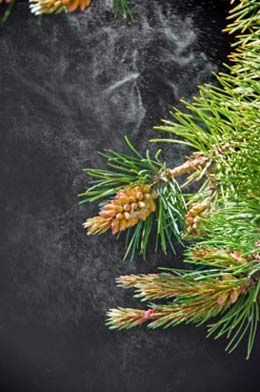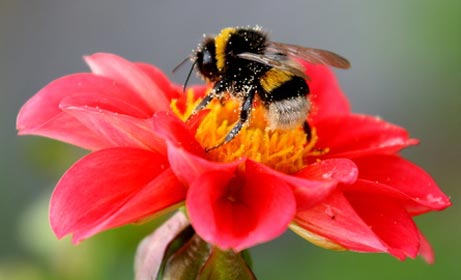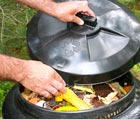- Gardening Tips |
- | What's NEW! |
- | Contact Us |
- | Sitemap
Plant Allergies - Gardening Tips Not to be Sneezed At
Plant allergies or gardening with allergies should never stop us from doing what we love to do. The joy of gardening can be experienced by the allergic sufferer and the non allergic person alike.
With a few helpful gardening tips, prior planning, and a minor lifestyle change, this can still be the perfect hobby.
The benefits of gardening certainly out weigh the minor changes that the allergic person may have to make. It gets us outside and into the sun. It is great exercise that we might not otherwise be getting. We may be tired when we are finished but our mental health always seems to be improved. The whole experience is a great stress-reducer.
Pollen Season
 Pine Pollen Being Released Into the Air
Pine Pollen Being Released Into the Air
At the same time of the year that we need to get the ground ready for planting, plants are producing pollen for reproduction. This process is going on from spring to fall and continues until the first frost.
The exact time that pollen production starts depends on your geographic location. The farther north you live, the later the season begins.
- Trees are the first on the list to cause spring allergies. Their season is primarily in the spring. Their season may not be as long as some other plants, however, they can release a lot of pollen in a short period of time.
- Grasses are next on the list. They produce pollen from late spring and continue into summer.
- Weeds are last to produce pollen. They begin late summer and continue into fall with some producing pollen until the first frost. Weeds produce more pollen than any other kind of plant and makes it more difficult for gardening with allergies.
Pollination
Pollen is what the male plant produces for reproduction. It needs to reach the female plant of the same species. This is not necessarily an easy task considering that neither plant can move. Nature accomplishes this in two ways:
- Nature uses the wind. The pollen is very small, light weight, and aerodynamic and a lot of pollen production is needed to reach it destination. When people get in the way, pollen allergy symptoms occur. These types of flowers tend to be not very attractive and do not attract insects. Even though the wind can carry the pollen far away, most of the pollen stays close to the source.
- Nature uses insects. These types of flowers seems to be more beautiful and attract insects. The pollen is heavier and larger. The pollen is sticky and sticks onto the insects as they rub against it. As the insects visit other flowers, the pollen rubs off. When this occurs inside of a female flower of the same species, fertilization occurs.
 Pollen on a Bee
Pollen on a Bee
Gardening with Plant Allergies
Knowing what the source and cause is for plant allergies allows us to make some changes to adapt. For example, pollen release occurs more in the early mornings and late afternoons. Try to plan gardening chores during the middle of the day.
Since we know that it is the male plants that produce the pollen, we can be more selective in what we choose to plant. Female plants will make it easier on our plant allergies. If you do choose to plants some male species, don't plant a large number of one kind.
Weather conditions can also affect us. Pollen counts in the air seem to be higher during hot, dry and windy days. Cloudy and cooler days without wind are preferred days to work in the garden for the nasal allergy sufferer. Rain washes the pollen out of the air. After a rain is a good time to be outdoors.
The American Academy of Allergy Asthma and Immunology website provides pollen counts for many parts of the U.S. You can find the count for your area by visiting the National Allergy Bureau on their site. It is noteworthy to point out that pollen counts are expressing information on what was occurring in yesterday's air.
Pollen only produces the allergic symptoms because it gets into our bodies through ports of entry such as the eyes or nose. It is there that we have mast cells that contain histamine. Pollen causes these cells to open up and to release the granules of histamine. As a result, sneezing, runny nose, water eyes and itchiness occur. If you experience allergies in the garden, wearing goggles and a pollen mask can greatly reduce symptoms.
Some more tips for gardening with plant allergies are listed below:
- Protect your body by using a hat, gloves, long sleeved shirts and long pants.
- Take off your clothes when you come in from gardening. Put your clothes in the laundry room so you don't spread pollen around your house.
- Take a shower after gardening. Wash out all of the pollen that your hair has collected.
- Use just one pair of shoes and keep them outside when you are not using them. Your shoes will carry in pollen on them.
- Work outside only during the time of lower pollen count.
- Don't rub your eyes or nose while working in the garden until you can wash your hands first. (Again, it is not letting the pollen in the ports of entry into our body.)
- Pollen is everywhere and impossible to avoid completely. Use a nasal irrigation system to rinse out the pollen from inside your nose when you come in from outdoors.
Related Content:
To Top of this Plant Allergies page
Return to Gardening Tips Home Page
Gardening Updates
Note: We'd love you to send us your tips on coping with plant allergies!
Please Contact Us and add to someone else's gardening experience in a good way.


The Comments Patch! - Add your off-shoots here: